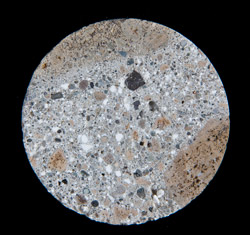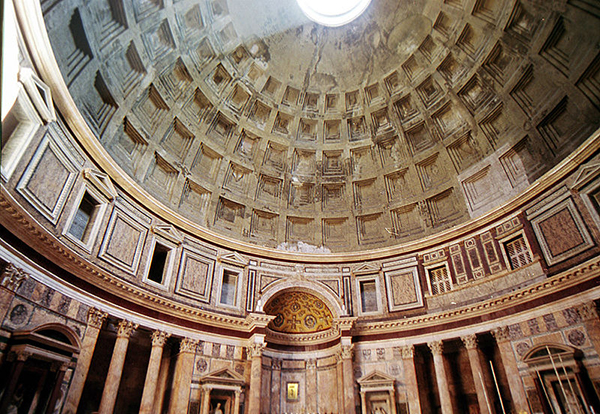
by Julia Rosen Thursday, June 20, 2013

A sample of Roman concrete collected for the study. Carol Hagan

The concrete ceiling of the Pantheon is a marvel of Roman construction. Wikimedia Commons
Each year, millions of visitors flock to Italy to wander among the remains of ancient Rome, where Cicero strolled and Augustus celebrated his expanding empire. Vestiges of the historic city center lie sprawled around the forum grounds like the abandoned playthings of a distracted giant: vertebrae of toppled columns, a crossword puzzle of ancient foundations, towering doorframes granting access to long-gone buildings. Above everything soars the lopsided profile of the Roman Colosseum, a structure as tough and stubborn as the gladiators that once battled in its ring.
Most visitors wonder at the grandeur of ancient Rome, at its surprising complexity and opulence. But it’s equally astonishing to ponder how these remains survived to be ogled in the first place. How did chunks of concrete withstand two millennia of Mediterranean climate when modern building facades begin to crumble after mere decades?
Scientists at the Lawrence Berkeley National Laboratory and the University of California at Berkeley have found part of the answer: The Romans really knew how to make concrete.
According to a new study in the Journal of the American Ceramic Society, ancient Romans produced cement by mixing lime from their abundant reserves of limestone (think the white cliffs of the Amalfi Coast) with widely available supplies of volcanic ash (think Mt. Vesuvius) to bind together the chunks of stone, known as aggregate, that make up the bulk of the concrete matrix. In contrast, when making Portland cement (the glue for most modern concrete), manufacturers heat lime along with silicon and aluminum-bearing clays (not ash) to a fiery 1,450 degrees Celsius. They then grind this product to a powder and mix it with water to set.
While water is necessary to hydrate the minerals (which helps them to adhere together), seawater (and seaspray) has the opposite effect, accelerating the weathering of industrial concrete in coastal areas. Because of its corrosive effects, it has long puzzled scientists that great quantities of Roman concrete have survived not only near, but often under, the salty surface of the Mediterranean for two millennia.
For the new study, lead author Marie Jackson of UC-Berkeley and colleagues sampled an ancient breakwater from Baiae, near Naples, Italy. The secret they uncovered is that seawater played an integral role in the durability of Roman cement designed for marine environments. After mixing the heated lime, ash and aggregate, the mixture was then left to set inside wooden molds that the Romans submerged in seawater. This allowed some interesting chemistry to take place — namely, it allowed a rare hydrothermal mineral called aluminum tobermorite to crystallize within the cement matrix, strengthening the concrete. Modern methods of concrete production aim to form crystal structures that simulate this robust mineral, but the Romans knew how to make the real deal.
Unraveling this mystery of Roman concrete has important implications for modern industrial production: Using volcanic ash requires less lime and lower temperatures to achieve superior durability, both of which translate into lower greenhouse gas emissions. (Heating lime during industrial production of Portland cement accounts for 7 percent of anthropogenic carbon dioxide emissions.) Deposits of volcanic ash also occur around the world, meaning that many countries that import Portland cement might have access to their own ingredients, although Roman-style cement is apparently unsuitable for applications that require fast-setting concrete.
Interestingly, the Roman method for making concrete was first documented in 30 B.C. by an engineer during the reign of Emperor Augustus. Only a few years later, construction of the most famous concrete structure in Rome began: the Pantheon. Amid the bustle of the modern city, its behemoth proportions still evoke a feeling of awe. With its vaulted ceiling of massive recessed concrete tiles that seem to defy gravity, it remains an enduring testament to the advancement and resolve of Roman engineering. And, as it turns out, to the Roman mastery of chemistry.
© 2008-2021. All rights reserved. Any copying, redistribution or retransmission of any of the contents of this service without the expressed written permission of the American Geosciences Institute is expressly prohibited. Click here for all copyright requests.